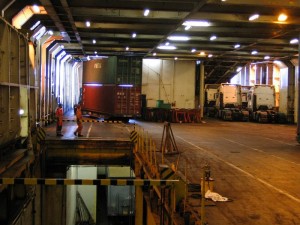“Ro-Ro” stands for the operation of ships or vessels that transport roll-on roll-off cargo, i.e., automobiles, trucks or commercial vehicles. Ro-Ro means “Roll On-Roll Off” and refers to the loading (roll on) and unloading (roll off) of these vehicles using ramps that can be stacked on the cargo ships or else permanently installed at the port itself. These ramps enable the loading and unloading of vehicles through the stern or the stern and the bow in a swift and straightforward process.
The roll-on roll-off cargo concept can be more easily understood if we compare it to Lo-Lo (“Lift On-Lift Off”) vessels, requiring a crane to lift and place cargo in its interior. However, with Ro-Ro, vehicles enter the vessel by themselves.
In terms of cargo type, it is also important to make the distinction between Ro-Ro and Ro-PAX, vessels that while similar, are suitable for passengers, and that are commonly referred to as ferries. It is also important to make the distinction between Ro-Ro vessels that accept all types of vehicles and machinery, and Car Carriers, which only accept cars. And last but not least, we have Ro-Lo, a container ship and Ro-Ro hybrid, which has two decks, each of which is designed for a particular cargo type.
Ro-Ro in multimodal transport
Ro-Ro vessels allow land transport operators to broaden their scope to include trucks and trailers. Fully loaded trucks can be transported by these vessels and continue their road route once they have disembarked in the destination port.
In this regard, Ro-Ro represents a guarantee for multimodal transport and provides a logistical advantage thanks to how it speeds up operations and minimises stowing and unstowing breakdowns. This all results in a quicker service, thanks to how it removes load handling steps, as well as being safer, due to how it does away with the need for the intervention of machinery such as gantry cranes or reach stackers. It is also a more efficient system, reducing petrol, vehicle and driver costs.
The origins of Ro-Ro
Up until the mid-19th century, vehicles were loaded onto ships in the same way as any other freight. Their tanks were emptied, their batteries unplugged and they were placed in the hold by cranes, where they were secured to prevent them from moving. It was a tedious operation that was also very risky to the integrity of the vehicles.
In 1849, the first ferry for trains was built in Scotland, while the LST (Landing Ship Tank) vessels that transported vehicles, cargo and troops during the Second World War laying the foundations for the Ro-Ro Vessel. The first Ro-Ro was built in 1956, with the design of the Searoad of Hyannis, with a capacity to transport three trucks between continental and Massachusetts and Nantucket Island.
Ro-Ro vs. containers
An approved ISO shipping container is fully capable of transporting vehicles in its interior. However, transporting a vehicle inside a container is not so advisable, unless we are transporting only a few units or we wish to send them in combination with another type of freight in the same container to take full advantage of its space. In any case, Ro-Ro is unrivalled for major vehicle numbers, thanks to which it is the usual port of call for automobile exporters or manufacturers.
Ro-Ro eliminates many intermediation costs, such as container stowing, unloading and loading. And if that was not enough, the loading and unloading of vehicles onto the vessel is much quicker. Vehicles inside a container are treated differently, as they will be generally considered as hazardous goods. This entails much more stringent customs documentation and stringent customs demands than those that would be required for the same vehicle if it was transported in the hold of a Ro-Ro vessel.
If your freight includes rolled vehicles and you are still not sure if Ro-Ro is the ideal solution for you, we at Bilogistik, specialists in the transport of all types of freight, can advise you on the services that best meets your needs to allow your cars, trucks or commercial equipment to be shipped to their destination in a completely safe manner.


